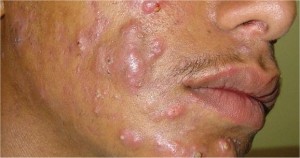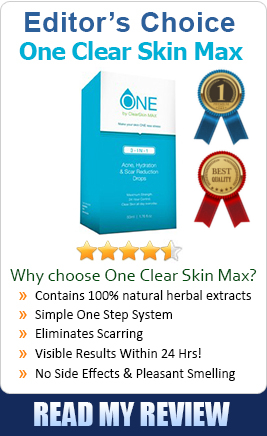While the word “acne” is frequently used commonly, many of us are not aware of the fact that acne is really a different type disease. Three major acne types are as under:
Acne Conglobata

Acne Conglobata
Acne Conglobata is a very severe form along with cyst formation and subsequent scarring. The causes of Acne Conglobata are still unknown.
However, most health practitioners are of opinion that it is largely depends on the genetics (family history).
Chromosomal defects are responsible for this acne. Most patients inherit it from their parents. Specific elements are known to trigger this acne. Toxic gases like halogens and dioxins and anabolic steroids can cause severe acne in some people. Discontinuation of a course of testosterone may also trigger it.
This condition presents with blackheads appearing around the neck, chest, face, upper arms and buttocks in groups of two or three. The pimples originate around the blackheads. They are large and engorged with fluid, and may be touch sensitive.
They remain for a while and continue to grow and fill with pus until they finally rupture. After the lesion has drained, it fills up again. After they rupture, several nodules can fuse together to form larger shapes. The lesions remain for a long time. They form a scab in the centre but they continue to spread outwards.
When the lesions do eventually heal, scars are left that can be the usual type of acne scar (atrophic) or can be the raised bump generally left behind by a burn or a cut. Acne Conglobata requires time to heal.
With various types of acne present, it is frequently tough to distinguish between these without your doctor’s help. Similarly, selecting a specific natural or herbal treatment is also a challenge for the specific type of acne that you have.
Acne Rosacea

Acne Rosacea
Acne Rosacea is a common skin problem often called “adult acne.” It is a chronic (long-term, progressive) acne-like eruption on the face ofmiddle aged and older adults associatedwith facial flushing.
Faired skinned and menopausal women are more likely to have Rosacea. Rosacea also appears to run in families.
It causes redness in the face and pimples’ central parts. Blood vessels under the skin of the face may become bigger and show through the skin as small red lines. The skin may be swollen and feel warm.
Women with Rosacea don’t have the same lesions as seen with common acne. They may have face flushing, when they are hot, drink alcohol or hot drinks, or eat spicy foods. This flushing causes the face to appear red. In the most severe form, this redness does not go away. The eyes may become swollen and nodules in the skin may be irritating.
Rosacea (pronounced roh-ZAY-sha) is a general but poorly known disorder of the facial skin that is estimated to affect well over 16 million Americans — and most of them are unaware it.
In fact, while rosacea is becoming increasingly widespread as the populous baby boom generation enters the most susceptible ages, a Gallup survey found that 78% of Americans have no knowledge of this condition, including how to recognize it and what to do about it.
Rosacea can be controlled but can not be cured. One very good example of a celebrity bearing this kind of acne is Sir Alex Ferguson, the manager of Manchester United. Because of its red-faced, acne-like effects on personal appearance, however, it can cause significant psychological, social and occupational problems if left untreated.
In surveys by the National Rosacea Society, more than 76% of rosacea patients said their condition had lowered their self esteem and self-confidence, and 41% reported that it had caused them to avoid public contact or cancel social engagements.
Among rosacea patients with severe symptoms, 88% admitted that the disorder had taken a toll on their professional interactions, and 51% said they had even missed work because of their condition.
While the cause of rosacea is yet to be discovered, today medical help is available that can control the symptoms and symptoms of this potentially life-disruptive disorder. Any one of the following warning signs is a signal to see a dermatologist or other knowledgeable physician for diagnosis and appropriate treatment before the signs and symptoms become increasingly severe:
- Redness on the nose, cheeks, forehead or chin
- Small visible blood vessels on the face
- Pimples or Bumps on the face.
- Irritated or watery eyes
Acne Vulgaris

Acne Vulgaris
Acne Vulgaris is the most common type of acne and it featurise as a superficial disease that affects the hair follicles and oil secreting skin glands.
The correct cause is unknown, although hormonal dysfunction, genetics and over-secretion of sebum are strongly implicated.
Risk factors include stress, steroids, cosmetics, and other drugs, mechanical skin irritants, oral contraceptives and climate.
This form of acne generally starts in puberty and affects about 80% of adolescents in some form. Males are affected more often; however, females have more severe and more prolonged cases. It manifests as whiteheads, blackheads, and inflammation (redness).
Acne Vulgaris is the acne’s least severe form. When we plainly refer to ‘acne”, we almost always mean “acne Vulgaris”. This type of acne is common under the skin on the neck, face, chest, or upper back.
Mild to moderate acne vulgaris consists of the following types of acne spots:
- Whiteheads: Whiteheads results when a pore is completely blocked, trapping sebum (oil), bacteria, and dead skin cells, causing a white appearance on the surface. Whiteheads are normally quicker in life cycle than blackheads.
- Blackheads: Blackheads give result when a pore is only blocked in part, allowing some of the trapped sebum (oil), and dead skin cells and bacteria to slowly drain to the surface. The black color is not due to the dirt. Rather, it is the skin’s own pigment, melanin, reacting with the oxygen existing in the air. A blackhead tends to be a stable structure, and can often take a long time to clear.
- Papules: Papules are red, inflamed, tender bumps with no head. Do not squeeze a papule. It will do no good, and may exacerbate scarring.
- Pustules: A pustule is inflamed, and looks like a red circle with a yellow or white center. Pustules are your garden variety zit. Before you squeeze or pop such a lesion, be sure to read about how to pop a pimple.



